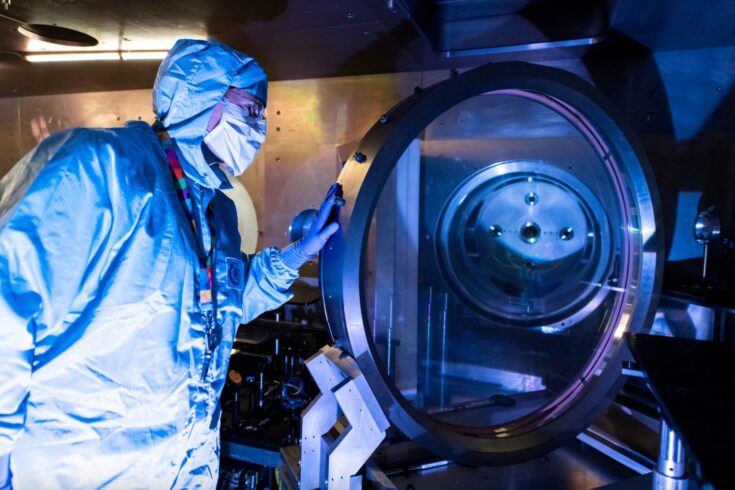The investment will support a major upgrade, which will include construction of the Vulcan 20-20 laser, which is set to be the most powerful laser in the world.
Harnessing lasers for physics
CLF, based at the STFC Rutherford Appleton Laboratory (RAL) in south Oxfordshire, uses a suite of lasers to create the fourth state of matter (in addition to solid, liquid, and gas) known as plasma.
Plasma is formed when normal matter is placed in extreme conditions, for example very high temperatures or pressures.
The particles in plasma behave in unusual ways that scientists can study to gain insights into the fundamental properties of all matter including in essential products such as batteries.
Vulcan 20-20 upgrade
Currently, the most powerful laser at CLF is the Vulcan laser, which has a wide range of uses, predominantly in plasma physics.
The upgraded Vulcan 20-20 laser will be 100 times brighter than its predecessor, and a million, billion, billion times brighter than the Sahara Desert’s brightest sunlight.
The Vulcan 20-20 laser is so named because it will generate a main laser beam with an energy output of 20 Petawatts (PW) alongside eight high energy beams with an output of up to 20 Kilojoules (KJ). This is a 20-fold increase in power which is expected to make it the most powerful laser in the world.
Meeting a global need
Although the CLF stands as a leading laser research facility, competition in this field has grown considerably in recent years.
Moreover, the Vulcan laser has been oversubscribed with applications since its opening in 1977, demonstrating the high-level of scientific need for a next-generation UK laser facility.
The Vulcan 20-20 upgrade programme is expected to take six-years to complete and will create a range of new jobs for scientists at different stages of their careers, as well as designers, engineers, and technicians.
Pushing scientific boundaries
The Vulcan 20-20 laser will help us better understand various scientific areas, from astrophysical phenomena like supernovae and solar flares to the potential of laser fusion as a clean energy source.
Planned experiments include creating matter-antimatter pairs using strong electromagnetic fields, usually only found in space, and studying a new particle acceleration method for potential ion radiotherapy treatments to treat cancer.
For the benefit of society
Professor Mark Thomson, Executive Chair of STFC and UK Research and Innovation (UKRI) Champion for Infrastructure, said:
The Central Laser Facility has been a driving force behind discoveries that have advanced our understanding of diverse areas from the fundamental properties of matter under extreme conditions to the formation of stars and planets. To keep this world leading facility at the forefront of science and to make new breakthroughs for the benefit of society, it is essential that we invest in the development and deployment of advanced high-power laser technology.
The Vulcan 20-20 programme will keep the Central Laser Facility at the cutting edge of the highest-power laser science and enable entirely new experiments in crucial areas such as renewable energy research.
Serve a new generation of scientists
Professor John Collier, Director of CLF, said:
Vulcan has been the flagship laser at CLF for many years, and widely recognised internationally as a pioneering facility.
Over the past 40 years, it has made important contributions to plasma physics research and hundreds of PhD students have been trained at the facility. It is timely for Vulcan to undergo its next major upgrade, making it ready to serve a new generation of scientists, ensuring the UK retains its leadership role in this field.
Boost UK science sector
George Freeman, Science Minister, said:
Reestablishing Britain as home to the world’s most powerful laser is an exciting opportunity to explore the unexplored in astronomy and physics, stride towards new clean energy sources for the good of our planet and much more.
By investing £85m to give our research community the edge in leading crucial scientific discoveries, we are also delivering hundreds of highly skilled jobs in science and engineering that boost the UK science sector and grow our economy.
STFC and CLF are currently recruiting for a range of roles to support the Vulcan 2020 upgrade programme including engineers, technicians, and project managers. Full details about the programme and these roles can be found on the CLF careers website.

